Mechanical Properties, Permeability, and Freeze–Thaw Resistance of Pervious Concrete Modified by Waste Crumb Rubbers
Abstract
:1. Introduction
2. Materials and Methods
2.1. Materials and Mix Design
2.2. Specimen Preparation
2.3. Testing Methods
3. Results and Discussions
3.1. Influence of Crumb Rubber on Pervious Concrete Properties
3.1.1. Permeability
3.1.2. Compressive Strength
3.1.3. Flexural Strength
3.1.4. Flexural Strain
3.1.5. Freeze–Thaw Resistance
4. Conclusions
- The permeability of rubber-modified pervious concrete is lower than that of control pervious concrete. The permeability decreases slightly with the increasing rubber content. Rubber particle size has little effect on permeability.
- The addition of rubber has a negative impact on the compressive strength of pervious concrete. Compressive strength decreases with the increase of rubber incorporation level. Although the addition of rubber reduces the compressive strength of the pervious concrete, it can still meet the requirements of non-structural use. Fine crumb rubber is more advantageous than coarse crumb rubber in modifying pervious concrete without sacrificing excessively compressive strength.
- The influence of rubber content on flexural strength is the same as on compressive strength. There is an obvious linear relationship between the compressive strength and flexural strength of rubber-modified pervious concrete. The addition of rubber enhances the flexural strain of pervious concrete. Flexural strain increases with the increasing rubber incorporation level. Fine crumb rubber significantly improves ductility without severely compromising the compressive strength, contrary to coarse crumb rubber.
- Freeze–thaw resistance of pervious concrete can be improved by the addition of crumb rubber. Rubber-modified pervious concrete has a better freeze–thaw resistance than that of control pervious concrete when subjected to the same freeze–thaw cycles. A high rubber incorporation level generates a high freeze–thaw resistance. Fine crumb rubber is superior to coarse crumb rubber in improving the freeze–thaw resistance of pervious concrete.
Author Contributions
Funding
Acknowledgments
Conflicts of Interest
References
- Piao, S.L.; Ciais, P.; Huang, Y.; Shen, Z.H.; Peng, S.S.; Li, J.S.; Zhou, L.P.; Liu, H.Y.; Ma, Y.C.; Ding, Y.H.; et al. The impacts of climate change on water resources and agriculture in China. Nature 2010, 467, 43–51. [Google Scholar] [CrossRef] [PubMed]
- Richards, D.R.; Edwards, P.J. Using water management infrastructure to address both flood risk and the urban heat island. Int. J. Water. Resour. D 2017, 34, 490–498. [Google Scholar] [CrossRef]
- Ho, H.L.; Huang, R.; Hwang, H.C.; Lin, W.T.; Hsu, H.W. Waste-based pervious concrete for climate-resilient pavements. Materials 2018, 11, 900. [Google Scholar] [CrossRef] [PubMed]
- Zhu, Z.H.; Chen, X.H. Evaluating the effects of low impact development practices on urban flooding under different rainfall intensities. Water 2017, 9, 548. [Google Scholar] [CrossRef]
- Hu, M.C.; Zhang, X.Q.; Siu, Y.L.; Li, Y.; Tanaka, K.; Yang, H. Flood mitigation by permeable pavements in Chinese sponge city construction. Water 2018, 10, 172. [Google Scholar] [CrossRef]
- Du, S.Q.; Shi, P.J.; Rompaey, A.V.; Wen, J.H. Quantifying the impact of impervious surface location on flood peak discharge in urban areas. Nat. Hazards 2015, 76, 1457–1471. [Google Scholar] [CrossRef]
- Huang, C.L.; Hsu, N.S.; Wei, C.C.; Luo, W.J. Optimal spatial design of capacity and quantity of rainwater harvesting systems for urban flood mitigation. Water 2015, 7, 5173–5202. [Google Scholar] [CrossRef]
- Liu, H.; Jia, Y.W.; Niu, C.W. “Sponge city” concept helps solve China’s urban water problems. Environ. Earth. Sci. 2017, 76, 473. [Google Scholar] [CrossRef]
- Xia, J.; Zhang, Y.Y.; Xiong, L.H.; He, S.; Wang, L.F.; Yu, Z.B. Opportunities and challenges of the sponge city construction related to urban water issues in China. Sci. China Earth. Sci. 2017, 60, 652–658. [Google Scholar] [CrossRef]
- Kim, H.K.; Lee, H.K. Acoustic absorption modeling of porous concrete considering the Gradation and shape of aggregate sand void ratio. J. Sound Vib. 2010, 329, 866–879. [Google Scholar] [CrossRef]
- García, G.D.C.; Treviño, R.B.; Fontaneda, L.A.S.; Muñoz, P.P. Influence of pervious pavement systems on heat dissipation from a horizontal geothermal system. Eur. J. Environ. Eng. 2013, 17, 956–967. [Google Scholar] [CrossRef]
- Ngohpok, C.; Sata, V.; Satiennam, T.; Klungboonkrong, P.; Chindaprasirt, P. Mechanical properties, thermal conductivity, and sound absorption of pervious concrete containing recycled concrete and bottom ash aggregates. KSCE J. Civ. Eng. 2018, 22, 1369–1376. [Google Scholar] [CrossRef]
- Siddique, R.; Naik, T.R. Properties of concrete containing scrap-tire rubber–an overview. Waste Manag. 2004, 24, 563–569. [Google Scholar] [CrossRef] [PubMed]
- Sukontasukkul, P.; Chaikaew, C. Properties of concrete pedestrian block mixed with crumb rubber. Constr. Build. Mater. 2006, 20, 450–457. [Google Scholar] [CrossRef]
- Shakrani, S.A.; Ayob, A.; Rahim, M.A.A. Applications of waste material in the pervious concrete pavement: A review. In Proceedings of the 3rd Electronic and Green Materials International Conference, Aonang Krabi, Thailand, 29–30 April 2017. [Google Scholar]
- Son, K.S.; Hajirasouliha, I.; Pilakoutas, K. Strength and deformability of waste tyre rubber-filled reinforced concrete columns. Constr. Build. Mater. 2011, 25, 218–226. [Google Scholar] [CrossRef] [Green Version]
- Segre, N.; Joekes, I. Use of tire rubber particles as addition to cement paste. Cem. Concr. Res. 2000, 30, 1421–1425. [Google Scholar] [CrossRef]
- Wongsa, A.; Sata, V.; Nematollahi, B.; Sanjayan, J.; Chindaprasirt, P. Mechanical and thermal properties of lightweight geopolymer mortar incorporating crumb rubber. J. Clean. Prod. 2018, 195, 1069–1080. [Google Scholar] [CrossRef]
- Pasandín, A.R.; Pérez, I. Fatigue performance of bituminous mixtures made with recycled concrete aggregates and waste tire rubber. Constr. Build. Mater. 2017, 157, 26–33. [Google Scholar] [CrossRef]
- Wang, X.; Xia, J.; Nanayakkara, O.; Li, Y.S. Properties of high-performance cementitious composites containing recycled rubber crumb. Constr. Build. Mater. 2017, 156, 1127–1136. [Google Scholar] [CrossRef]
- Meddah, A.; Bensaci, H.; Beddar, M.; Bali, A. Study of the effects of mechanical and chemical treatment of rubber on the performance of rubberized roller-compacted concrete pavement. Innov. Infrastruct. Solut. 2017, 2, 17. [Google Scholar] [CrossRef]
- Gonen, T. Freezing-thawing and impact resistance of concretes containing waste crumb rubbers. Constr. Build. Mater. 2018, 177, 436–442. [Google Scholar] [CrossRef]
- Bisht, K.; Ramana, P.V. Evaluation of mechanical and durability properties of crumb rubber concrete. Constr. Build. Mater. 2017, 155, 811–817. [Google Scholar] [CrossRef]
- Azevedo, F.; Pacheco-Torgal, F.; Jesus, C.; De Aguiar, J.B.; Camões, A.F. Properties and durability of HPC with tyre rubber wastes. Constr. Build. Mater. 2012, 34, 186–191. [Google Scholar] [CrossRef] [Green Version]
- Guo, S.; Dai, Q.; Si, R.; Sun, X.; Lu, C. Evaluation of properties and performance of rubber-modified concrete for recycling of waste scrap tire. J. Clean. Prod. 2017, 148, 681–689. [Google Scholar] [CrossRef]
- Chandrappa, A.K.; Biligiri, K.P. Pervious concrete as a sustainable pavement material—Research findings and future prospects: A state-of-the-art review. Constr. Build. Mater. 2016, 111, 262–274. [Google Scholar] [CrossRef]
- Bonicelli, A.; Fuentes, L.G.; Bermejo, I.K.D. Laboratory investigation on the effects of natural fine aggregates and recycled waste tire rubber in pervious concrete to develop more sustainable pavement materials. In Proceedings of the World Multidisciplinary Civil Engineering-Architecture-Urban Planning Symposium, Prague, Czech Republic, 12–16 June 2017. [Google Scholar]
- Mondal, S.; Biligiri, K.P. Crumb rubber and silica fume inclusions in pervious concrete pavement systems: Evaluation of hydrological, functional, and structural properties. J. Test. Eval. 2018, 46, 892–905. [Google Scholar] [CrossRef]
- Gesoglu, M.; Güneyisi, E.; Khoshnaw, G.; Ipek, S. Investigating properties of pervious concretes containing waste tire rubbers. Constr. Build. Mater. 2014, 63, 206–213. [Google Scholar] [CrossRef]
- Gesoglu, M.; Güneyisi, E.; Khoshnaw, G.; Ipek, S. Abrasion and freezing–thawing resistance of pervious concretes containing waste rubbers. Constr. Build. Mater. 2014, 73, 19–24. [Google Scholar] [CrossRef]
- Liu, H.B.; Luo, G.B.; Wei, H.B.; Yu, H. Strength, permeability, and freeze-thaw durability of pervious concrete with different aggregate sizes, porosities, and water-binder ratios. Appl. Sci. 2018, 8, 1217. [Google Scholar] [CrossRef]
- Ministry of Housing and Urban-Rural Construction of the People’s Republic of China. Technical Specification for Pervious Cement Concrete Pavement; Ministry of Housing and Urban-Ural Construction of the People’s Republic of China: Beijing, China, 2009. (In Chinese)
- Ministry of Housing and Urban-Rural Construction of the People’s Republic of China. Standard for Test Method of Mechanical Properties on Ordinary Concrete; Ministry of Housing and Urban-Ural Construction of the People’s Republic of China: Beijing, China, 2002. (In Chinese)
- Ministry of Housing and Urban-Rural Construction of the People’s Republic of China. Standard for Test Methods of Long-Term Performance and Durability of Ordinary Concrete; Ministry of Housing and Urban-Ural Construction of the People’s Republic of China: Beijing, China, 2009. (In Chinese)
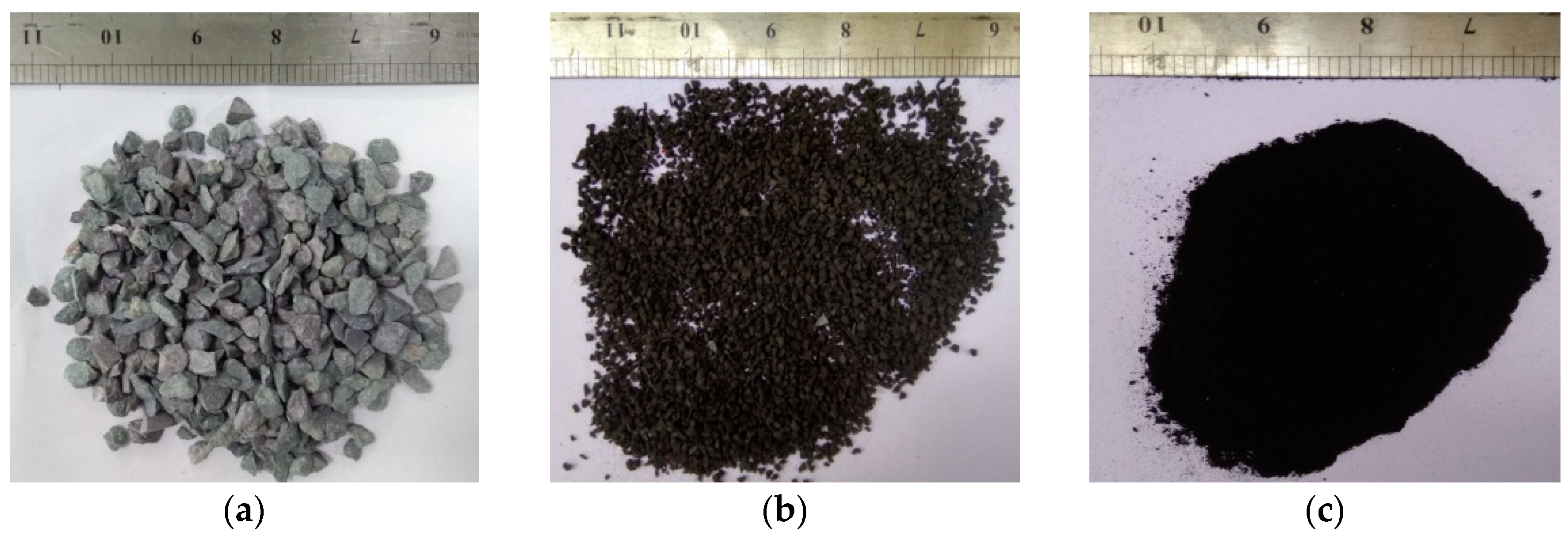

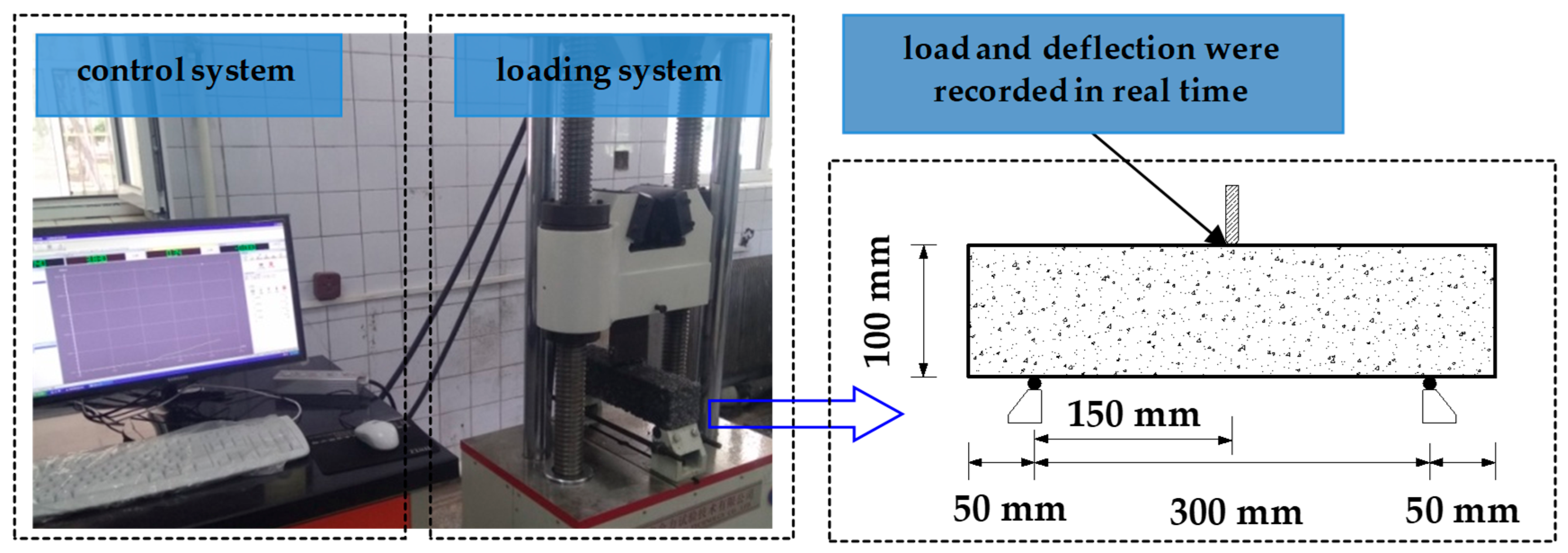


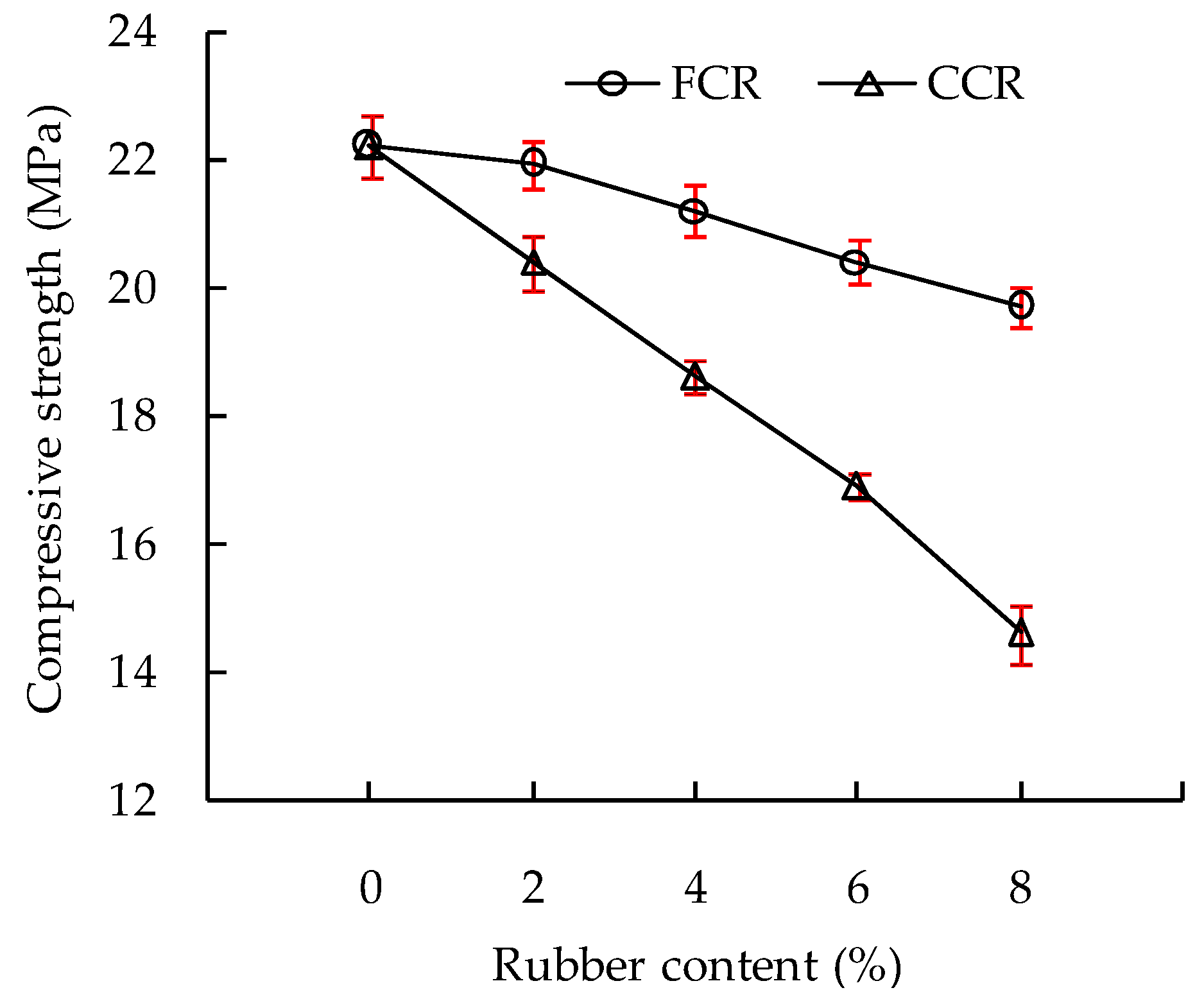
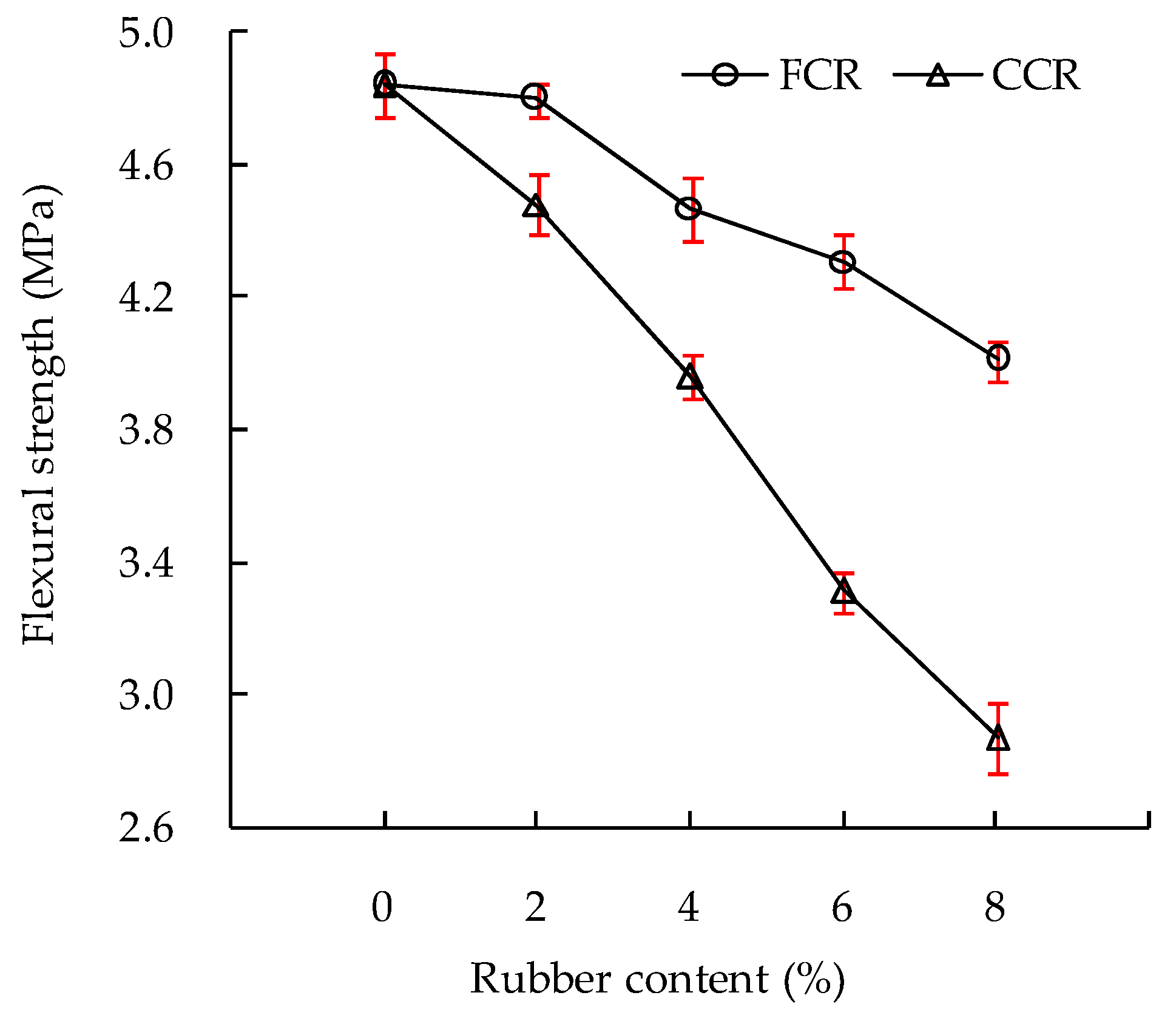
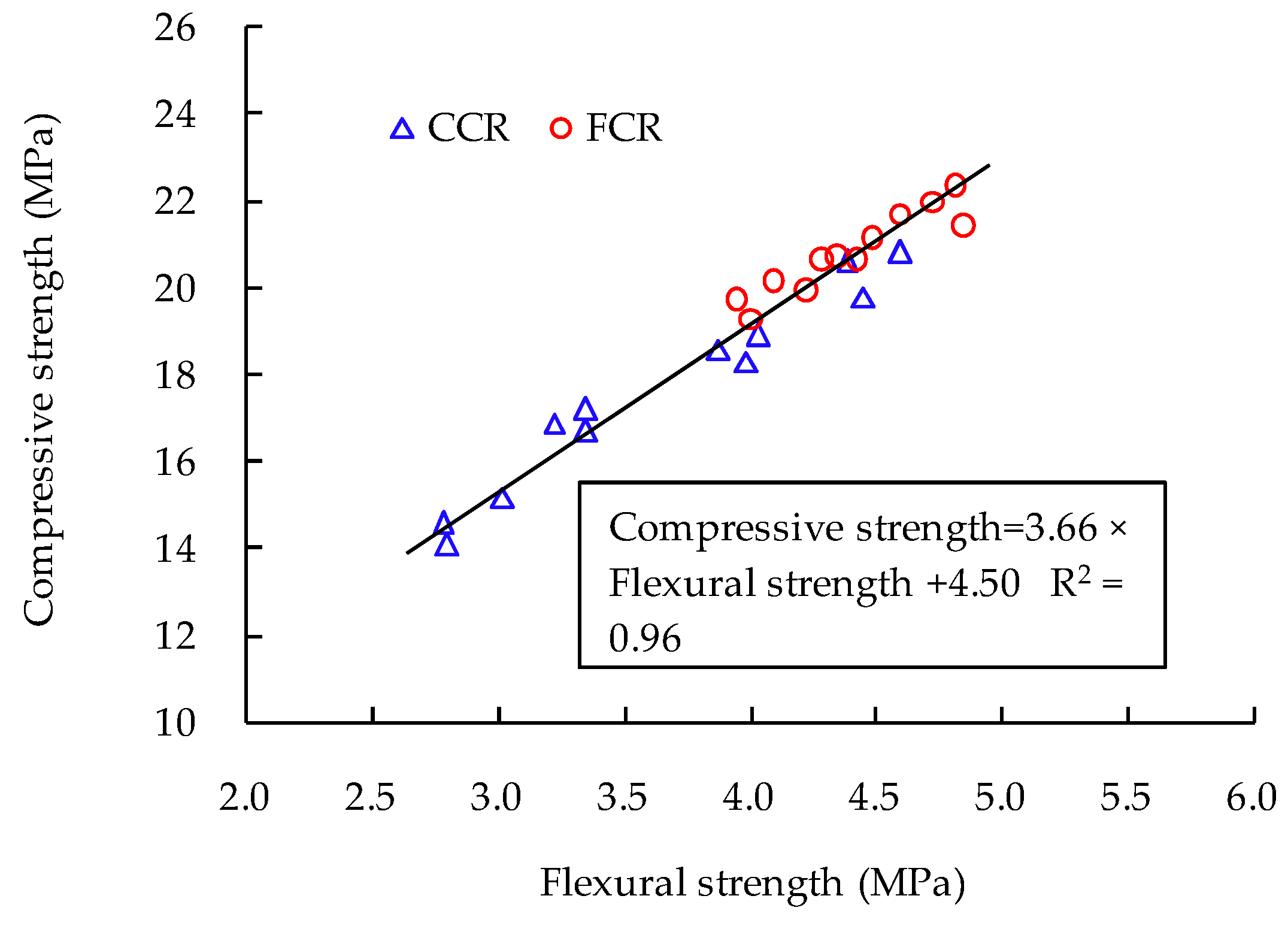
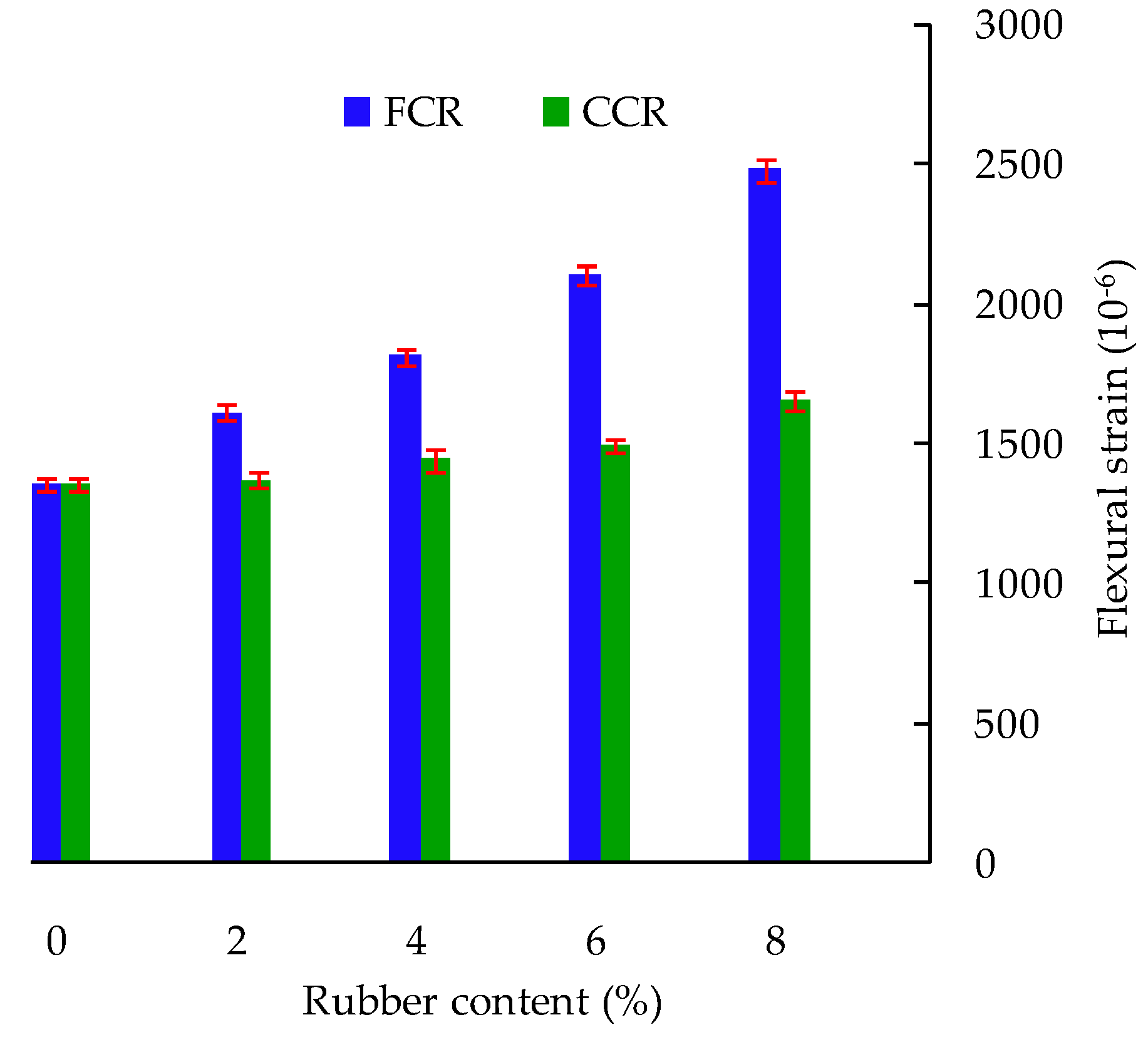


| Density (g/cm3) | Specific Surface Area (m2/kg) | Setting Time (min) | Compressive Strength (MPa) | Flexural Strength (MPa) | |||
|---|---|---|---|---|---|---|---|
| Initial Setting | Final Setting | 3d | 28d | 3d | 28d | ||
| 2.96 | 342 | 182 | 251 | 21.8 | 47.6 | 4.7 | 7.5 |
| Chemical Composition (%) | |||||
|---|---|---|---|---|---|
| SiO2 | Al2O3 | CaO | MgO | Fe2O3 | SO3 |
| 22.6 | 5.6 | 62.7 | 1.7 | 4.3 | 2.5 |
| Size (mm) | Apparent Density (kg/m3) | Bulk Density (kg/m3) | Bulk Porosity (%) | Crushing Value (%) | Needle-Like Particle Content (%) | Water Absorption (%) |
|---|---|---|---|---|---|---|
| 4.75–9.5 | 2749 | 1409 | 48.7 | 9.9 | 7.7 | 1.71 |
| Mix ID | Coarse Aggregate | Cement | Water | Superplasticizer | CCR | FCR |
|---|---|---|---|---|---|---|
| Control | 1503 | 480 | 144 | 3.84 | 0 | 0 |
| CCR-2 | 1503 | 480 | 144 | 3.84 | 9.6 | 0 |
| CCR-4 | 1503 | 480 | 144 | 3.84 | 19.2 | 0 |
| CCR-6 | 1503 | 480 | 144 | 3.84 | 28.8 | 0 |
| CCR-8 | 1503 | 480 | 144 | 3.84 | 38.4 | 0 |
| FCR-2 | 1503 | 480 | 144 | 3.84 | 0 | 9.6 |
| FCR-4 | 1503 | 480 | 144 | 3.84 | 0 | 19.2 |
| FCR-6 | 1503 | 480 | 144 | 3.84 | 0 | 28.8 |
| FCR-8 | 1503 | 480 | 144 | 3.84 | 0 | 38.4 |
| Mix ID | Permeability Coefficient (mm/s) | Compressive Strength (MPa) | Flexural Strength (MPa) | Flexural Strain (×10−6) | ||||
|---|---|---|---|---|---|---|---|---|
| Mean | St. Dev. | Mean | St. Dev. | Mean | St. Dev. | Mean | St. Dev. | |
| Control | 3.91 | 0.12 | 22.2 | 0.50 | 4.84 | 0.09 | 1354 | 21 |
| CCR-2 | 3.89 | 0.14 | 20.4 | 0.43 | 4.48 | 0.10 | 1372 | 25 |
| CCR-4 | 3.64 | 0.15 | 18.6 | 0.24 | 3.96 | 0.07 | 1444 | 37 |
| CCR-6 | 3.54 | 0.19 | 16.9 | 0.21 | 3.31 | 0.06 | 1492 | 25 |
| CCR-8 | 3.23 | 0.18 | 14.6 | 0.45 | 2.87 | 0.11 | 1654 | 30 |
| FCR-2 | 3.92 | 0.09 | 21.9 | 0.37 | 4.80 | 0.05 | 1611 | 29 |
| FCR-4 | 3.75 | 0.11 | 21.2 | 0.41 | 4.47 | 0.10 | 1811 | 25 |
| FCR-6 | 3.50 | 0.15 | 20.4 | 0.33 | 4.31 | 0.08 | 2104 | 32 |
| FCR-8 | 3.36 | 0.12 | 19.7 | 0.33 | 4.01 | 0.06 | 2482 | 40 |
| Mix ID | Compressive Strength After Freeze-Thaw Cycles (MPa) | |||||||
|---|---|---|---|---|---|---|---|---|
| 25 Cycles | 50 Cycles | 75 Cycles | 100 Cycles | |||||
| Mean | St. Dev. | Mean | St. Dev. | Mean | St. Dev. | Mean | St. Dev. | |
| Control | 21.2 | 1.00 | 18.1 | 0.49 | 16.7 | 0.54 | 14.2 | 0.90 |
| CCR-2 | 19.5 | 0.49 | 16.9 | 0.65 | 15.7 | 0.29 | 13.8 | 1.08 |
| CCR-4 | 18.0 | 0.33 | 15.5 | 0.62 | 14.6 | 0.57 | 13.6 | 0.46 |
| CCR-6 | 16.6 | 0.25 | 14.3 | 0.57 | 13.6 | 0.62 | 12.8 | 1.01 |
| CCR-8 | 14.3 | 0.62 | 12.8 | 0.34 | 12.3 | 0.48 | 11.7 | 0.56 |
| FCR-2 | 21.0 | 0.22 | 18.4 | 0.34 | 17.4 | 0.42 | 15.3 | 0.86 |
| FCR-4 | 20.5 | 0.48 | 18.2 | 0.52 | 17.2 | 0.70 | 15.6 | 0.62 |
| FCR-6 | 20.0 | 0.34 | 17.6 | 0.57 | 17.2 | 0.61 | 15.8 | 0.66 |
| FCR-8 | 19.3 | 0.56 | 17.5 | 0.33 | 17.0 | 0.41 | 16.5 | 0.41 |
© 2018 by the authors. Licensee MDPI, Basel, Switzerland. This article is an open access article distributed under the terms and conditions of the Creative Commons Attribution (CC BY) license (http://creativecommons.org/licenses/by/4.0/).
Share and Cite
Liu, H.; Luo, G.; Gong, Y.; Wei, H. Mechanical Properties, Permeability, and Freeze–Thaw Resistance of Pervious Concrete Modified by Waste Crumb Rubbers. Appl. Sci. 2018, 8, 1843. https://doi.org/10.3390/app8101843
Liu H, Luo G, Gong Y, Wei H. Mechanical Properties, Permeability, and Freeze–Thaw Resistance of Pervious Concrete Modified by Waste Crumb Rubbers. Applied Sciences. 2018; 8(10):1843. https://doi.org/10.3390/app8101843
Chicago/Turabian StyleLiu, Hanbing, Guobao Luo, Yafeng Gong, and Haibin Wei. 2018. "Mechanical Properties, Permeability, and Freeze–Thaw Resistance of Pervious Concrete Modified by Waste Crumb Rubbers" Applied Sciences 8, no. 10: 1843. https://doi.org/10.3390/app8101843





